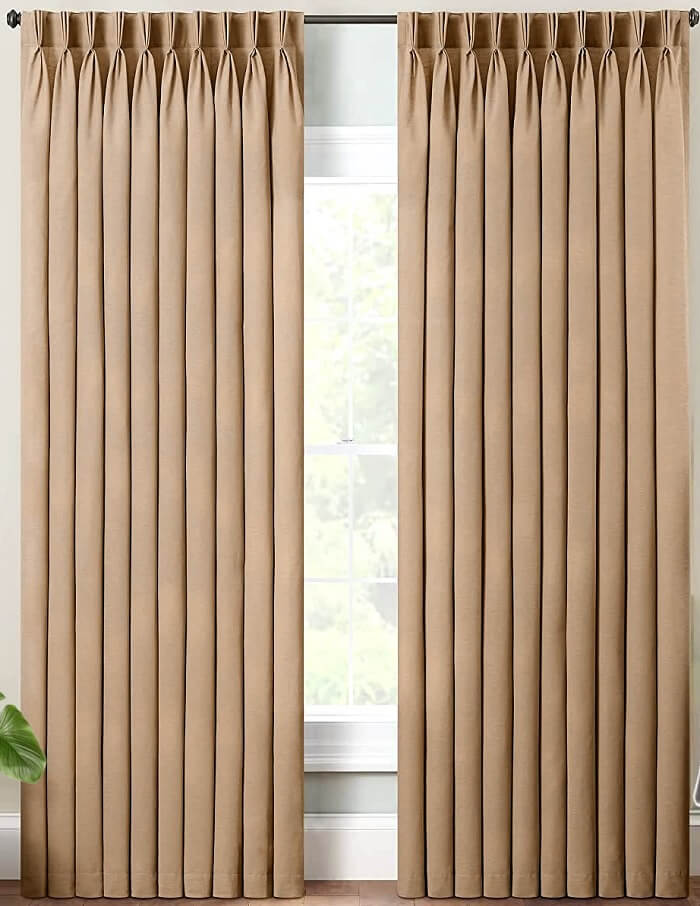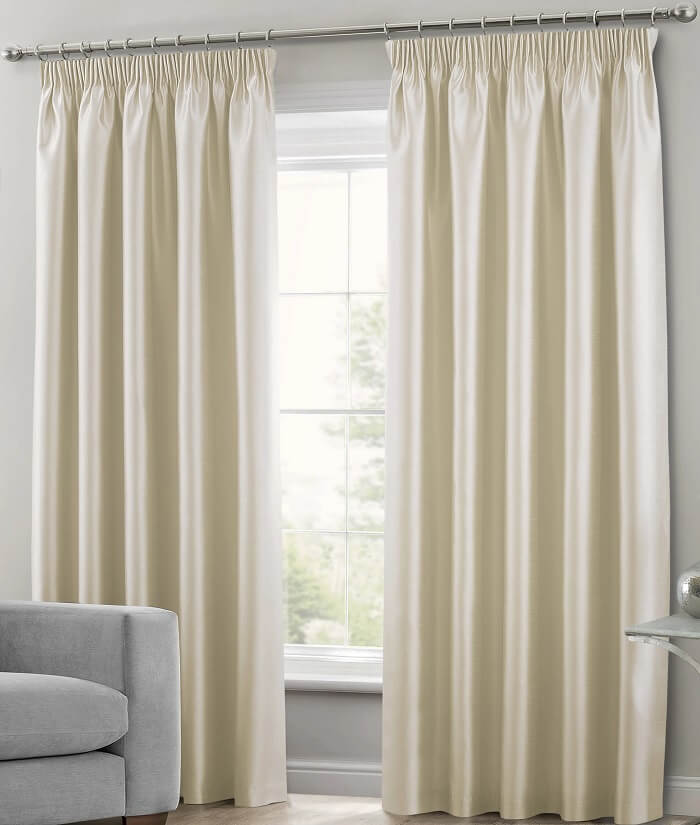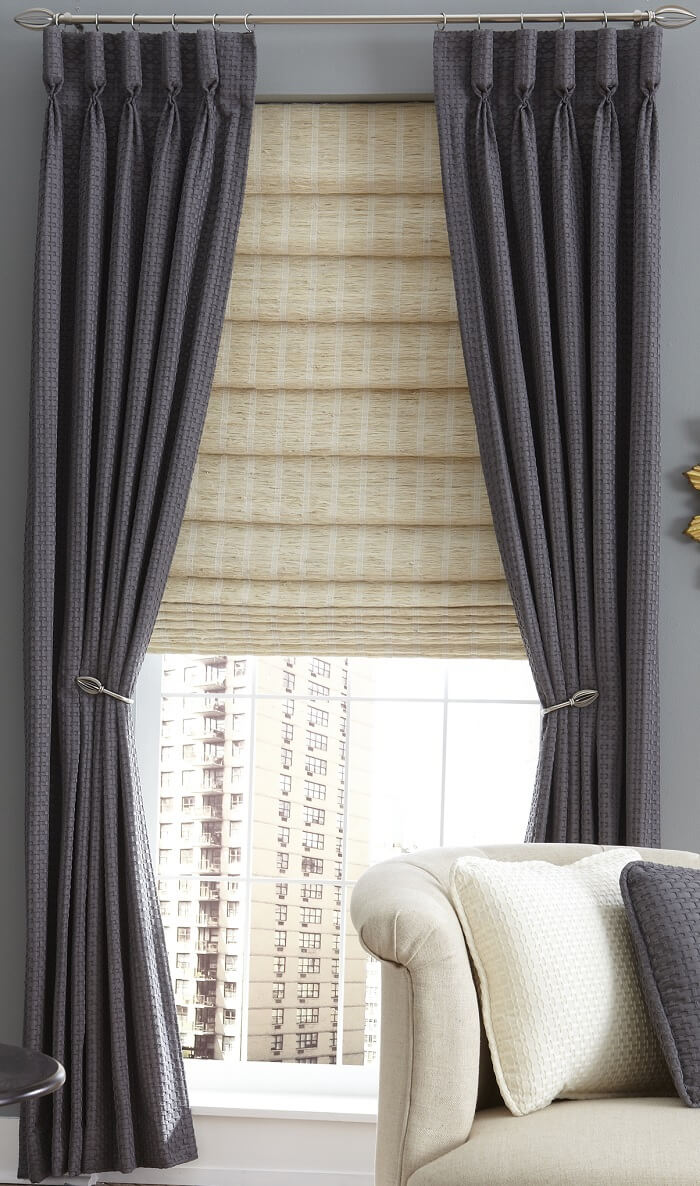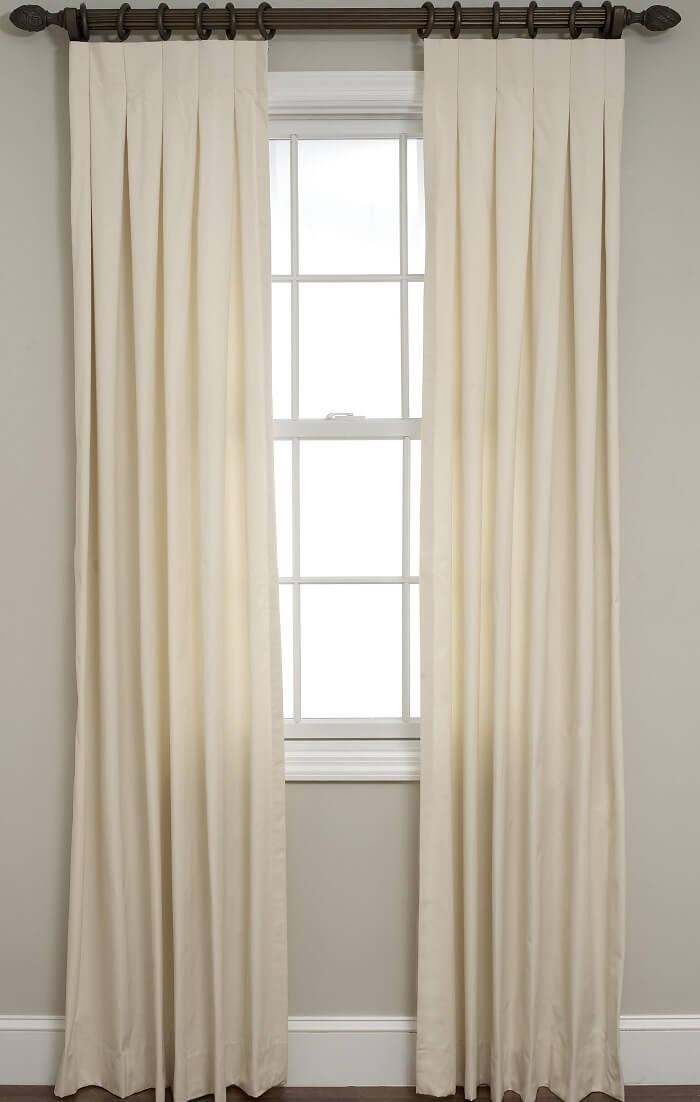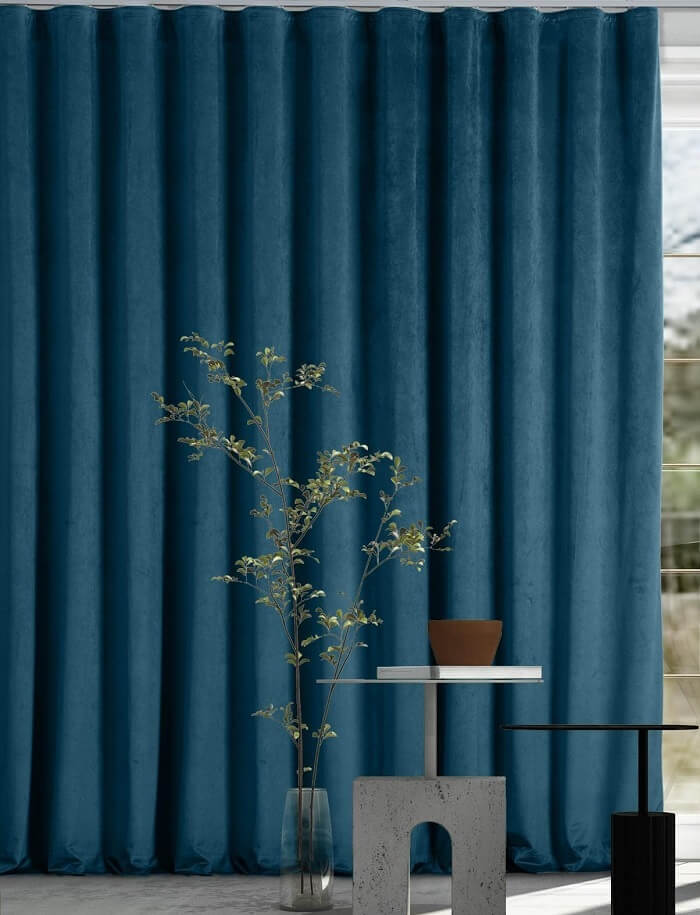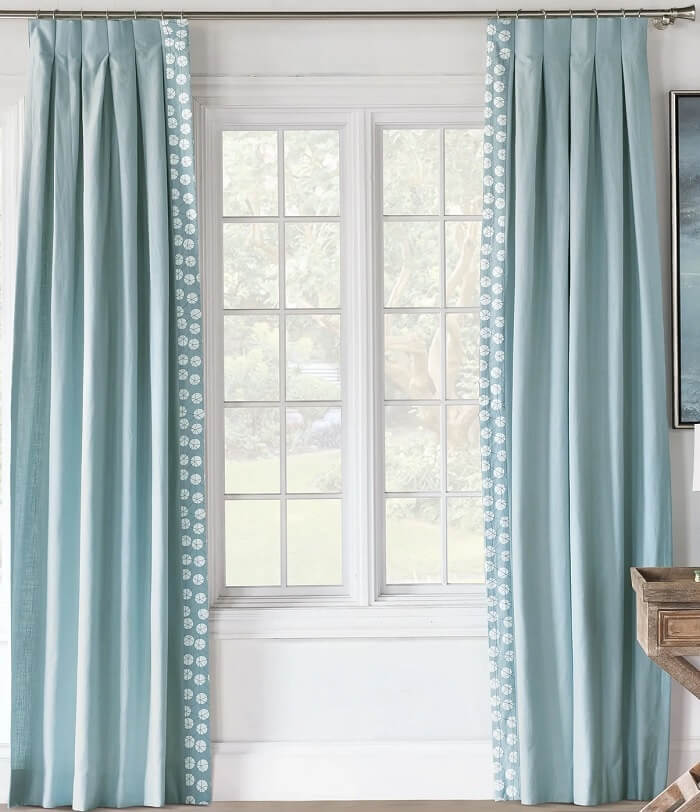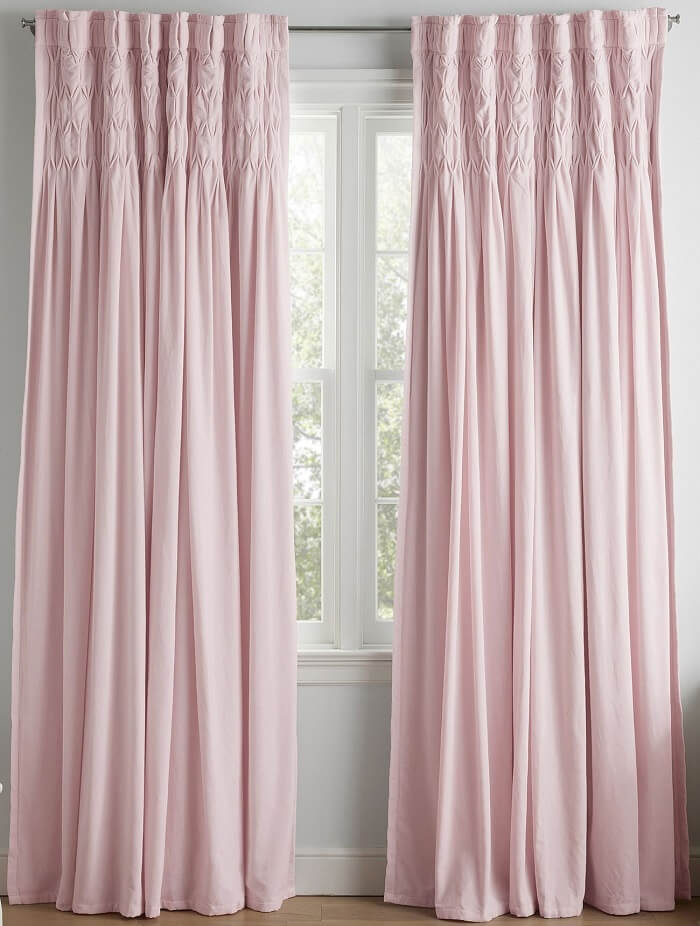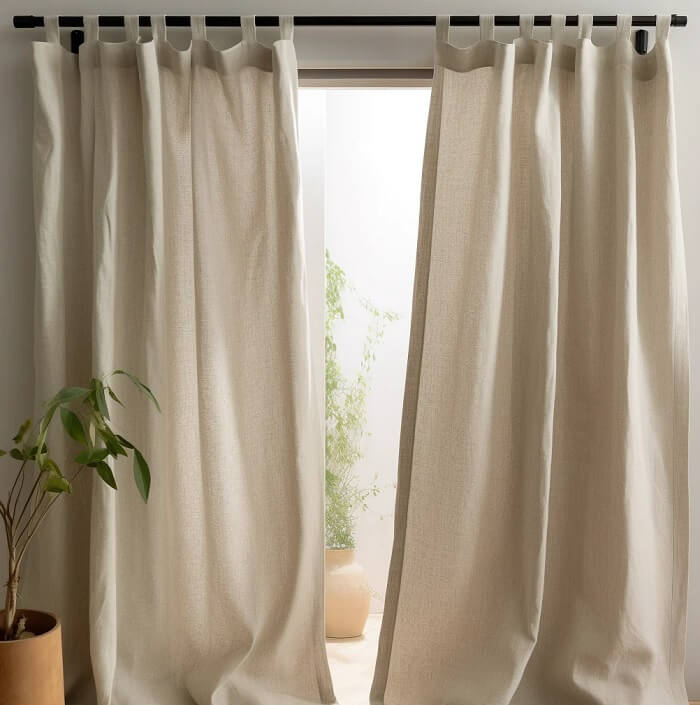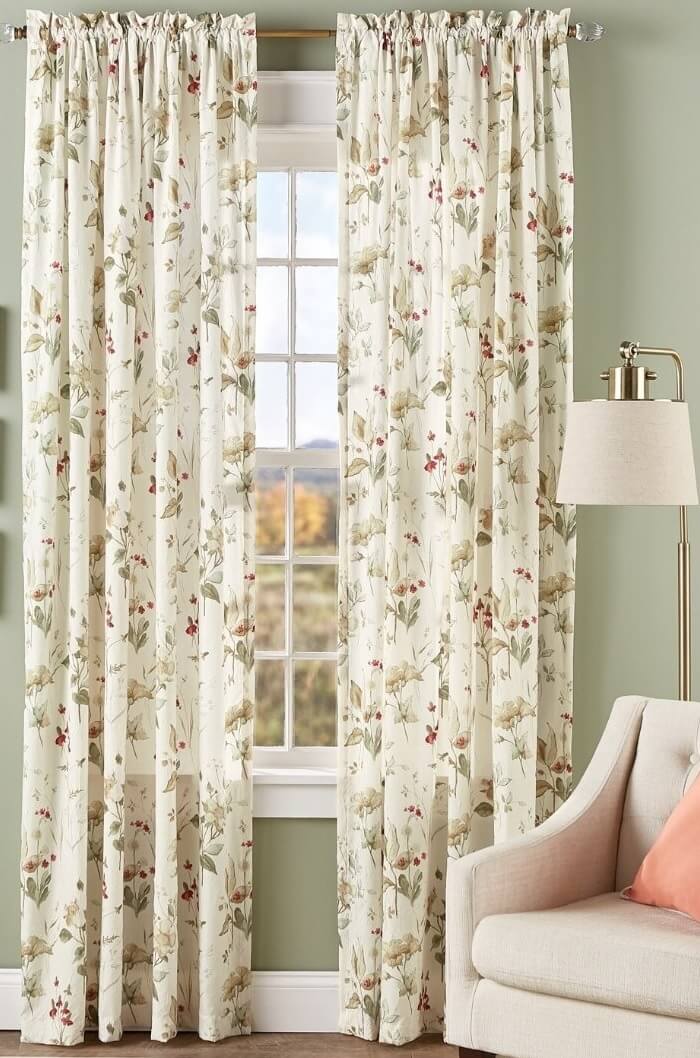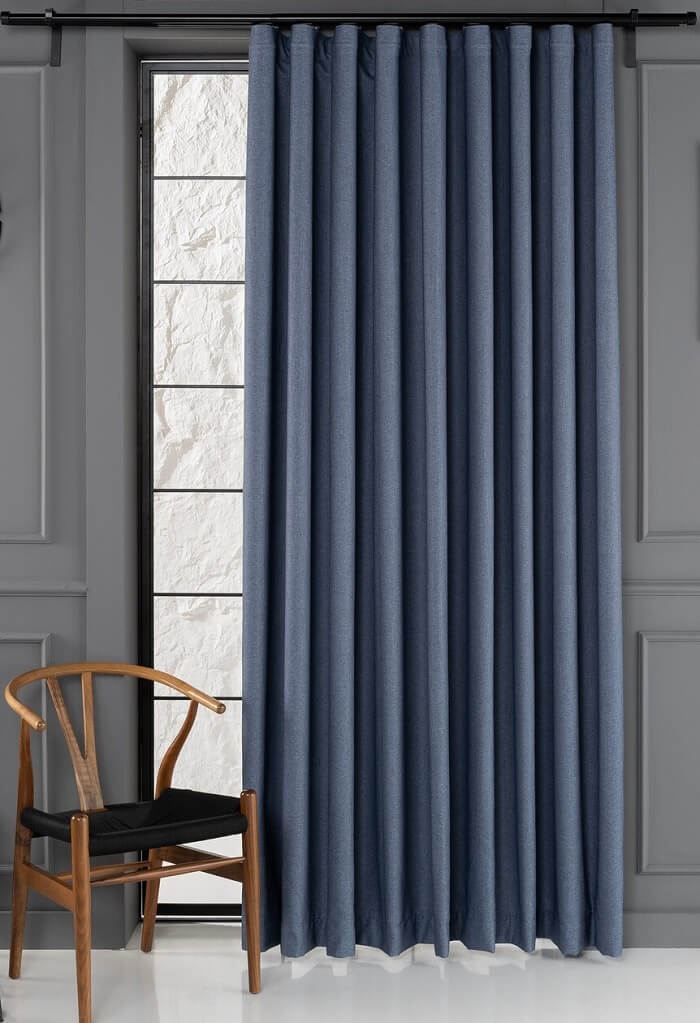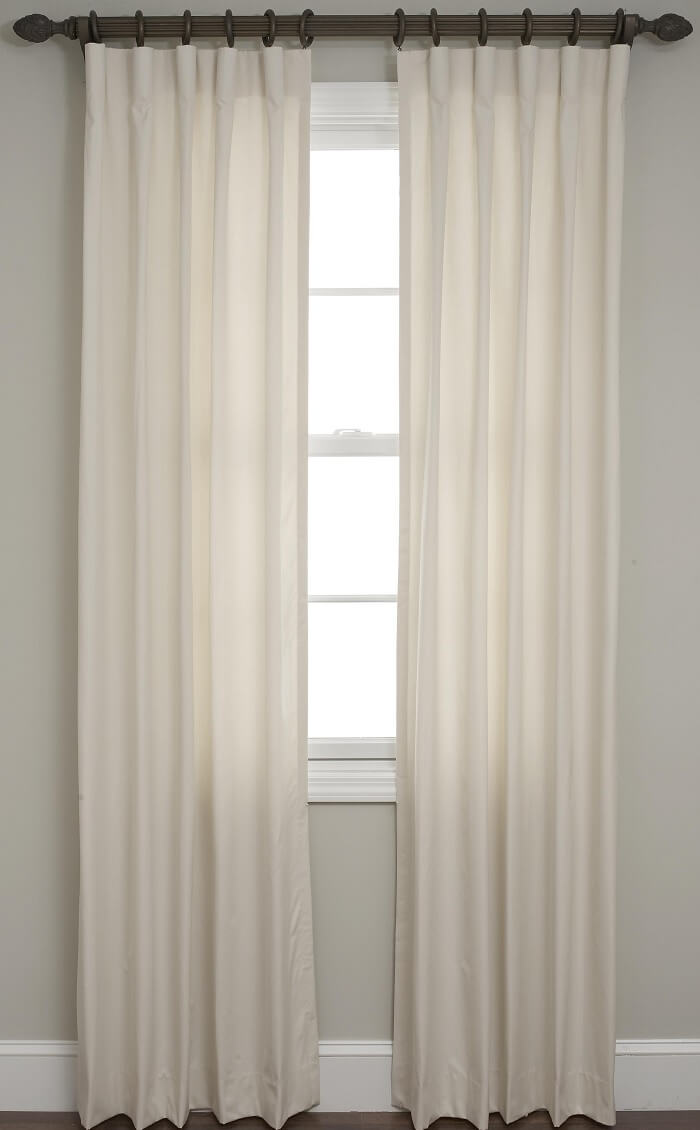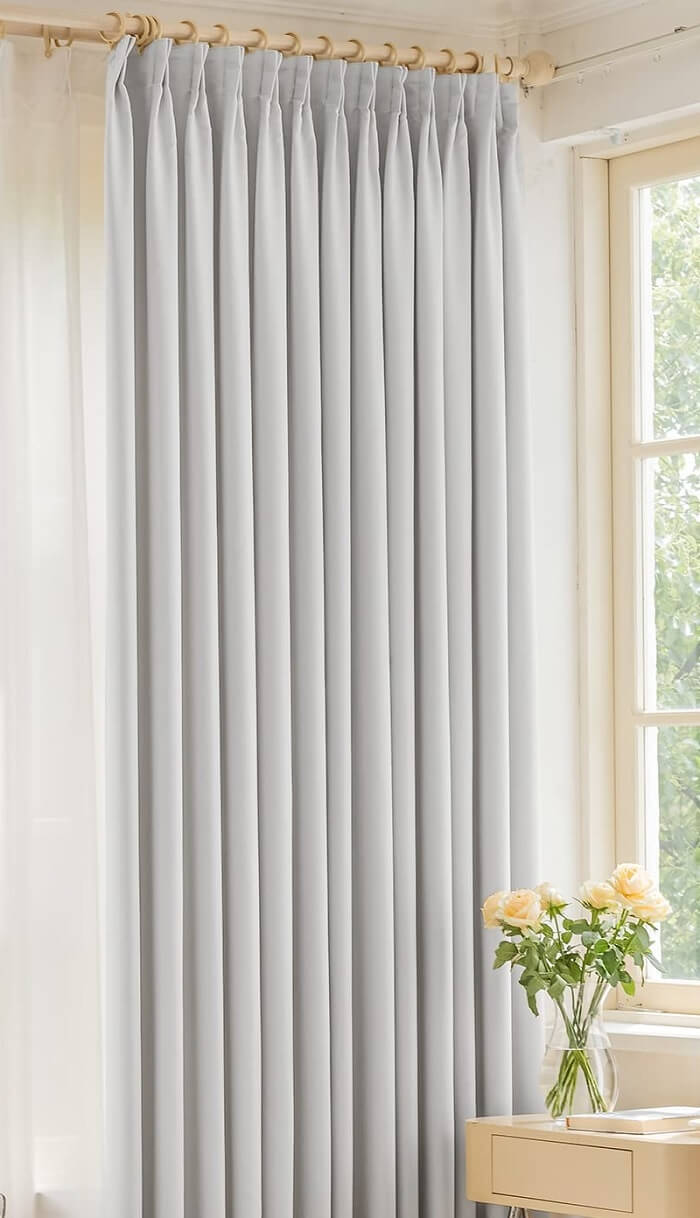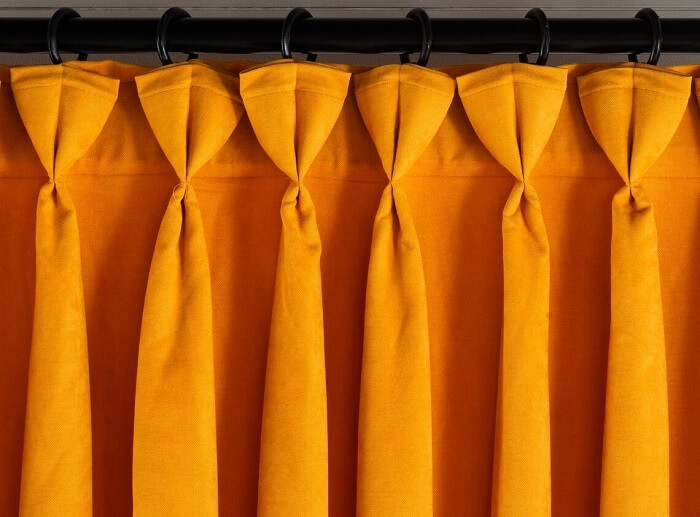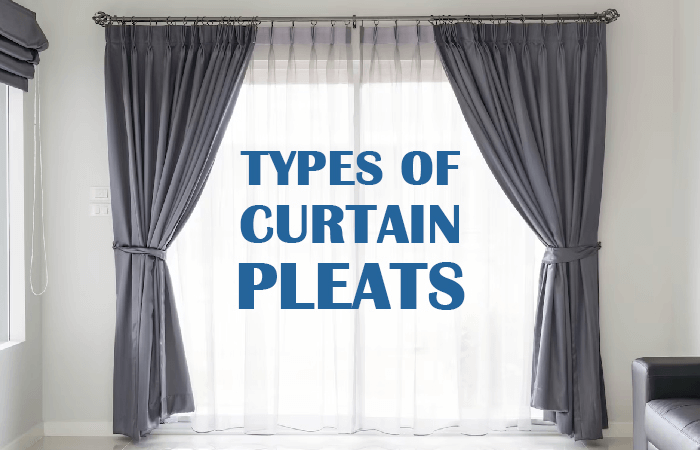
14 Types of Curtain Pleats
In this guide, we delve into the world of curtain pleats, exploring the diverse options that can transform your windows into works of art.
- Pinch Pleats
- Pencil Pleats
- Goblet Pleats
- Box Pleats
- Ripplefold Pleats
- Inverted Pleats
- Dutch/French Pleats (Pleat à la Française)
- Smocked Pleats
- Tab Top Curtains
- Rod Pocket Pleats
- S-Fold or Wave Pleats
- Cartridge Pleats
- Tailored Pleat
- Butterfly Pleats
Here’s a guide to different types of curtain pleats:
1. Pinch Pleats
Pinch pleats are the epitome of timeless elegance. The fabric is gathered regularly, forming a series of pinches that run vertically along the curtain. Choose a double pinch for a more luxurious look or a triple pinch for added opulence.
When to Use: If your home features traditional or classic decor, pinch pleat curtains seamlessly fit into this aesthetic.
Where to Use: Best suited for living rooms, dining rooms, and spaces with a sophisticated ambiance.
How to Make: Fabric is gathered at regular intervals, forming pinches that add a tailored and structured appearance.
Suits With: Works well with heavy fabrics, enhancing the luxurious feel.
Purpose: Offers a timeless and elegant look.
Pros: Timeless and elegant appearance, suitable for formal spaces, versatile with fabric choices, works well with heavy materials, and provides a structured and tailored look.
Cons: It can be challenging to clean, and may appear too formal for some casual spaces.
2. Pencil Pleats
If versatility is what you seek, pencil pleats are your go-to choice. Also known as tape pleats, these curtains have a gathered and tightly spaced appearance resembling a row of pencils neatly aligned. Pencil pleats work well with various fabric types and can be easily adjusted to suit different window sizes, making them a versatile option for any room.
When to Use: Suitable for various occasions and adaptable to different interior styles.
Where to Use: Versatile enough for any room, from bedrooms to living spaces.
How to Make: Fabric is tightly gathered, resembling a row of pencils neatly aligned.
Suits With: Works well with various fabric types, making it adaptable to different window sizes.
Purpose: Provides a classic, tailored look that can be easily adjusted to suit different design preferences.
Pros: Adaptable to various styles, works with different fabrics, easily adjustable for different window sizes, provides a classic and tailored look, versatile for any room.
Cons: May not offer as much visual impact as other pleat styles.
3. Goblet Pleats
Unveil a touch of regality with goblet pleats. Resembling the shape of a wine goblet, these pleats create a luxurious and tailored look. Goblet pleats are best suited for heavy fabrics, adding a sense of grandeur to formal spaces. These curtains are perfect for those who wish to infuse a touch of aristocracy into their interior design.
When to Use: Perfect for creating a sense of grandeur and formality.
Where to Use: Ideally used in formal settings such as grand living rooms or dining areas.
How to Make: Fabric is gathered into a shape resembling a wine goblet, creating a luxurious appearance.
Suits With: Best suited for heavy fabrics, add to the regal feel.
Purpose: Infuses a touch of aristocracy into interior design, creating a statement look.
Pros: Adds a touch of grandeur, works well with heavy fabrics, provides a luxurious appearance, ideal for formal settings, and creates a structured and tailored look.
Cons: May be too opu lent for some modern or casual spaces.
4. Box Pleats
For a clean and modern aesthetic, box pleats are the way to go. These pleats are characterized by a crisp, square-fold design that runs vertically along the curtain. Box pleats are excellent for contemporary spaces, providing a streamlined appearance that complements minimalist décor. This style is particularly effective with solid-colored fabrics, allowing the clean lines to take center stage.
When to Use: Suitable for contemporary and minimalist design styles.
Where to Use: Perfect for modern living spaces, offices, or areas with a streamlined aesthetic.
How to Make: Fabric is folded into crisp, square folds, creating a clean and modern appearance.
Suits With: Particularly effective with solid-colored fabrics, they emphasize clean lines.
Purpose: Offers a sleek and uncluttered look, complementing modern decor effortlessly.
Pros: Sleek and uncluttered appearance, suitable for contemporary spaces, works well with solid-colored fabrics, emphasizes clean lines, perfect for minimalist decor.
Cons: May lack the intricate detailing of other pleat styles.
5. Ripplefold Pleats
Embrace the beauty of simplicity with ripple fold pleats. This style features continuous, evenly-spaced folds that create a gentle, undulating effect when the curtain is open. Ripple-fold pleats are not only aesthetically pleasing but also highly functional, allowing for smooth and effortless operation when opening and closing the curtains. This style is perfect for a modern, streamlined look in both residential and commercial settings.
When to Use: Great for achieving a modern and streamlined appearance.
Where to Use: Suitable for residential and commercial spaces seeking a clean, sophisticated look.
How to Make: Features continuous, evenly spaced folds for a gentle, undulating effect when opened.
Suits With: Functional design allows for smooth and effortless operation.
Purpose: Combines aesthetic appeal with practical functionality for a graceful window treatment.
Pros: Sleek and uncluttered appearance, suitable for contemporary spaces, works well with solid-colored fabrics, emphasizes clean lines, perfect for minimalist decor.
Cons: May lack the intricate detailing of other pleat styles.
6. Inverted Pleats
For those who appreciate subtlety, inverted pleats offer a refined and understated chic look. Also known as reverse or box pleats, these inverted folds face inward, creating a clean and tailored appearance. Inverted pleats work exceptionally well with solid fabrics, allowing the structural design to shine. This style is perfect for spaces where you desire a touch of sophistication without overwhelming the overall decor.
When to Use: Ideal for those seeking a refined and understated look.
Where to Use: Suited for both formal and informal spaces, adding a touch of sophistication without being overpowering.
How to Make: The fabric is folded inward, creating a clean and tailored appearance.
Suits With: Works well with solid fabrics, allowing the structural design to stand out.
Purpose: Offers a subtle and chic style, perfect for those who appreciate understated elegance.
Pros: Refined and understated appearance, adaptable to different settings, works well with solid fabrics, provides a clean and tailored look, and adds a touch of sophistication.
Cons: May lack the visual impact of more elaborate pleat styles.
7. Dutch/French Pleats (Pleat à la Française)
Step into the world of timeless romance with French pleats. These pleats, also known as triple pleats, are characterized by three equally spaced folds that bring an air of grace and sophistication to your windows. French pleats work exceptionally well with medium to heavy fabrics, adding a touch of luxury to bedrooms and formal living areas. Embrace the essence of classic French elegance with this enduring pleat style.
When to Use: Perfect for creating a timeless and romantic atmosphere.
Where to Use: Ideally used in bedrooms or formal living areas where a touch of classic elegance is desired.
How to Make: Characterized by three equally spaced folds, exuding grace and sophistication.
Suits With: Well-suited for medium to heavy fabrics, enhancing the luxurious feel.
Purpose: Bring a touch of classic French elegance, adding a romantic flair to your windows.
Pros: Timeless and romantic appearance, ideal for bedrooms and formal spaces, works well with medium to heavy fabrics, exudes grace and sophistication, and adds a touch of classic French elegance.
Cons: May be too formal for some casual settings.
8. Smocked Pleats
Infuse an artistic flair into your space with smocked pleats. These handcrafted pleats feature decorative fabric manipulation, creating a textured and visually interesting look. Smocked pleats are an excellent choice for those who appreciate craftsmanship and want to add a touch of uniqueness to their interiors. This style is perfect for eclectic or bohemian-themed rooms, where a touch of whimsy is warmly welcomed.
When to Use: Ideal for those who want to infuse artistic elements into their space.
Where to Use: Perfect for eclectic or bohemian-themed rooms, adding a touch of whimsy.
How to Make: Handcrafted pleats featuring decorative fabric manipulation for a textured look.
Suits With: Suited for those who appreciate the craftsmanship and desire a unique window treatment.
Purpose: Adds an artistic and unconventional flair, making a statement in creative interior design.
Pros: Adds artistic and unique flair, perfect for eclectic or bohemian themes, handcrafted for a textured look, works well with vibrant fabrics, and showcases craftsmanship.
Cons: Not suitable for all design styles, maybe too whimsical for some spaces.
9. Tab Top Curtains
If a laid-back, casual charm is what you seek, tab-top curtains might be the answer. Instead of traditional pleats, these curtains have fabric loops or tabs sewn along the top edge, allowing the curtain to be threaded through the rod. Tab top curtains offer a relaxed and informal look, making them perfect for spaces like bedrooms and kitchens where a cozy ambiance is desired.
When to Use: Ideal for creating a laid-back and casual atmosphere.
Where to Use: Suited for bedrooms and kitchens where a cozy ambiance is desired.
How to Make: Fabric loops or tabs along the top edge allow the curtain to be threaded through the rod.
Suits With: Provides a relaxed and informal look, perfect for a comfortable living space.
Purpose: Effortless simplicity that brings a touch of casual charm to your windows.
Pros: Laid-back and casual appearance, suited for bedrooms and kitchens, provides a relaxed look, easy to install, and adds a touch of charm.
Cons: May lack the structured appearance of traditional pleat styles.
10. Rod Pocket Pleats
Embrace the beauty of simplicity with rod pocket pleats. In this style, the curtain features a sewn-in pocket along the top edge through which the rod is threaded. Rod pocket pleats create a soft and gathered appearance, providing a simple yet elegant touch to your windows. This style works well with lightweight fabrics and is an excellent choice for those who appreciate a minimalist aesthetic.
When to Use: Perfect for those who appreciate a simple, uncluttered look.
Where to Use: Well-suited for various spaces, especially those with a minimalist aesthetic.
How to Make: Features a sewn-in pocket along the top edge, allowing the rod to be threaded through.
Suits With: Ideal for lightweight fabrics, creating a soft and gathered appearance.
Purpose: Effortless simplicity that adds a touch of elegance to your windows without overwhelming the decor.
Pros: An effortlessly simple appearance, suitable for various spaces, adds a touch of elegance, works well with lightweight fabrics, easy to install.
Cons: May lack the tailored look of more structured pleat styles.
11. S-Fold or Wave Pleats
Introducing the S-fold pleats, also known as the wave fold or ripple fold with a distinctive twist. The unique structure of S-fold pleats allows for smooth and effortless operation, making them a popular choice for those seeking both style and functionality. S-fold pleats are particularly versatile, seamlessly complementing a variety of interior design themes. Whether adorning the windows of a minimalist living room or adding a touch of elegance to a sophisticated bedroom, the clean lines and graceful curves of S-fold pleats bring a sense of refined style to any space.
When to Use: Perfect for creating a contemporary and fluid appearance.
Where to Use: Suited for modern living rooms and bedrooms seeking a sleek and stylish look.
How to Make: Fabric is shaped into continuous S-folds or waves, creating a seamless and elegant drape.
Suits With: Works well with light to medium-weight fabrics, allowing for a graceful flow.
Purpose: Adds a touch of sophistication and visual interest.
Pros: Creates a contemporary and fluid appearance, ideal for modern spaces, works well with light to medium-weight fabrics, is easy to maintain, and adds a touch of sophistication.
Cons: May not suit traditional or classic design styles.
12. Cartridge Pleats
Cartridge pleat curtains are perfect for those who appreciate the meticulous craftsmanship of traditional drapery. The cylindrical rolls add a touch of architectural flair to the window treatment, turning the curtains into a focal point of refinement within your living space. In the world of window treatments, cartridge pleat curtains stand as a testament to the enduring allure of classic elegance.
When to Use: Ideal for those aiming for a structured and opulent window treatment.
Where to Use: Suited for formal spaces like dining rooms and grand foyers.
How to Make: Fabric is tightly gathered in a cylindrical shape, creating a series of bold pleats.
Suits With: Works best with heavy fabrics, enhancing the luxurious and regal appearance.
Purpose: Evokes a sense of grandeur and formality, making a bold statement in upscale interiors.
Pros: Structured and opulent appearance, ideal for formal spaces, works well with heavy fabrics, enhances the luxurious feel, and makes a bold statement.
Cons: May be challenging to clean and maintain, and may appear too heavy for some settings.
13. Tailored Pleat
Tailored pleats offer a contemporary and geometric aesthetic, characterized by crisp and sharply defined folds. These pleats are carefully measured and sewn to create a clean and modern look. Tailored pleats work well with solid colors and bold patterns, making them an ideal choice for spaces where you want to showcase the precision of modern design.
When to Use: Perfect for those who seek a tailored and customized window treatment.
Where to Use: Suited for any room where a personal touch is desired.
How to Make: Pleats are spaced according to personal preference, offering a unique and bespoke appearance.
Suits With: Allows customization with various fabric choices, patterns, and pleat styles.
Purpose: Provides a unique look and the overall design scheme.
Pros: Offers a tailored and customized look, ideal for personalized preferences, allows for various fabric choices and pleat styles, creates a one-of-a-kind appearance, and suits different design schemes.
Cons: May require more effort in customization and decision-making, potentially higher cost depending on fabric choices.
14. Butterfly Pleats
Butterfly pleats, also known as butterfly folds, introduce a soft and whimsical touch to curtain design. These pleats create a charming and playful appearance. Butterfly pleats work particularly well with lightweight and sheer fabrics, adding a subtle elegance to spaces like bedrooms or sunlit living areas.
Where to Use: Suitable for use in bedrooms, living rooms, dining areas, and even offices to add a touch of elegance.
When to Use: Perfect for use in rooms with a classic or contemporary decor style.
How to Make: Create butterfly pleats by evenly folding the fabric in a V-shape, resembling butterfly wings. Secure the pleats with clips or pins to maintain the distinctive look. Adjust the spacing between pleats based on personal preference for a tailored appearance.
Suits With: Matches well with light and airy fabrics, enhancing the overall effect of the pleats.
Purpose: Allows for customizable light control and privacy, making it a practical and stylish window treatment.
In conclusion, exploring the diverse world of curtain design unveils a plethora of options, with a focus on enhancing aesthetics and functionality. The myriad types of curtain pleats serve as a testament to the artistry within interior decor. From classic pinch pleats exuding timeless elegance to contemporary wave pleats embodying modern sophistication, each style caters to unique tastes and design preferences. By understanding curtain pleat types, homeowners and designers alike can transform spaces into personalized sanctuaries, blending form and function seamlessly. Embracing the versatility of curtain pleats allows for a harmonious integration of style, texture, and ambiance in any living space.
Cheryl Carter
Latest posts by Cheryl Carter (see all)
- Custom Leather Patches for Hats: Elevate Your Style by Choosing the Perfect - February 27, 2024
- Types of Curtain Pleats: Explore and Elevate Your Interior Design - February 6, 2024
- Korean Perm Hairstyles Male: Get the K-Pop Look - November 24, 2023
